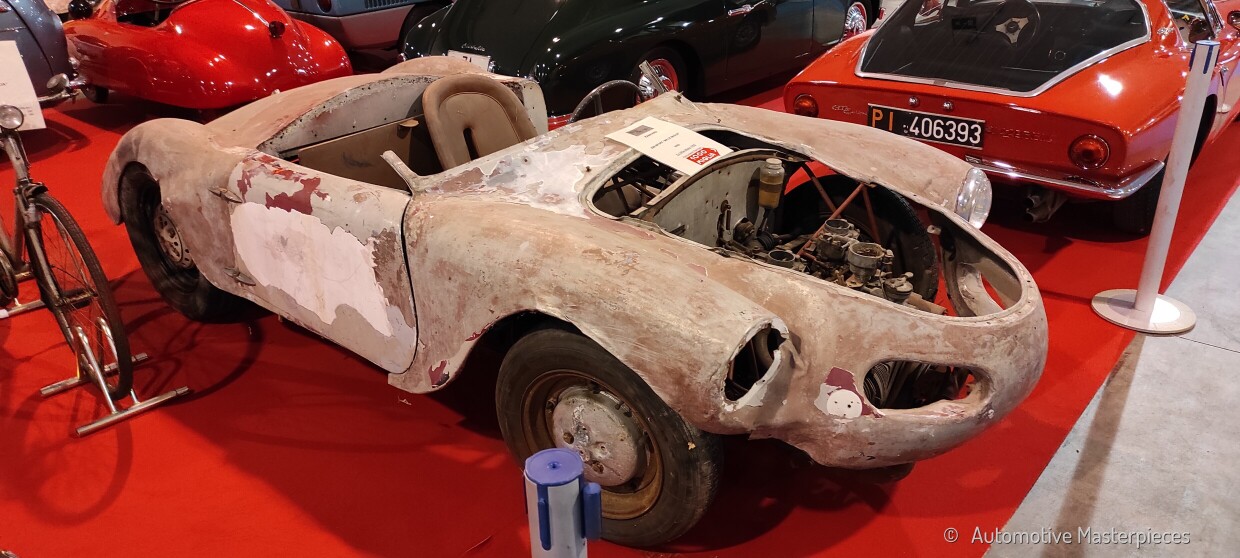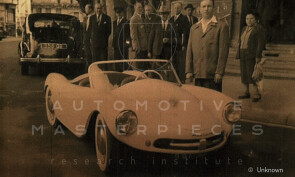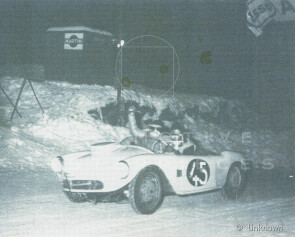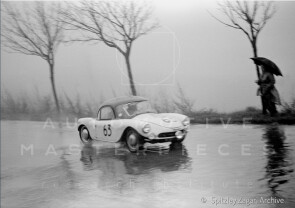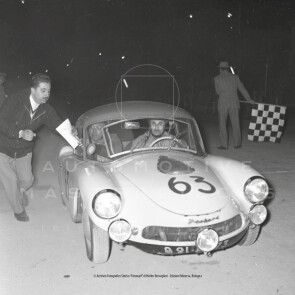
1952 Panhard Dyna X86
ON/OFF
Why am I an Automotive Masterpiece?
The Panhard Dyna X was a subcompact car produced by the French manufacturer Panhard from 1948 to 1953. It holds the distinction of being the first mass-produced car with an all-aluminum body. In 1943, engineer Jean-Albert Grégoire presented a car that incorporated many of the technical principles of the Amilcar Compound (notably its chassis and suspension). The project was initiated by Aluminium Français to promote the use of aluminum in automotive construction, but initially failed to attract the interest of manufacturers. However, under the framework of the “Plan Pons,” Panhard reached an agreement with Grégoire to continue development of the AFG prototype (Aluminium Français – Grégoire), providing the mechanical components. The result was the Dyna, featuring an aluminum body on a steel frame, an air-cooled 610 cc aluminum flat-twin engine, a four-speed gearbox, independent suspension on all four wheels (coil springs in front and torsion bars at the rear), and—most notably—front-wheel drive. The Dyna was first shown at the 1946 Paris Motor Show, and production began in October 1947, with bodywork subcontracted to Facel-Métallon (later known for producing the luxurious Facel Vega). From 1948, the car was sold as the Dyna X type 100 (X84), with only minimal changes from the 1946 prototype. The name referenced its top speed of 100 km/h. In 1950, the model gained a new grille with a central circular motif, and the type 110 (X85) replaced the 100. The 610 cc engine (classified as 3 CV) was upgraded from 22 to 28 hp (SAE). In April 1950, a new 745 cc engine (4 CV) producing 32–34 hp was introduced in the type 120 (X86). In February 1952, an optional Sprint version of the 4 CV engine offered 36–37 hp, thanks to a revised camshaft and a twin-barrel carburetor. In April, a roadster derivative named Dyna X Junior was launched. In June, the type 130 (X87) received a more powerful 5 CV / 851 cc engine, while the older types 110 and 120 were discontinued in December. For the 1953 model year, the type 130 could reach a top speed of 130 km/h when fitted with the Sprint 5 CV / 40 hp engine. The Dyna X was a surprisingly spacious vehicle for its class: at 3.82 meters long, it approached the dimensions of higher-segment cars, though its modest engine placed it in direct competition with models like the Renault 4CV, one of its main rivals. The Dyna X was available as a saloon, convertible, and station wagon, with a van version (Dyna K) also produced. Its design was decidedly unconventional, with a rounded body and protruding front headlights. Although the public was initially skeptical due to its unusual styling, the car eventually gained popularity for its agile handling and fuel economy. Performance was also commendable for the time. Built on a tubular chassis, the Dyna X’s aluminum alloy body kept its weight low, enhancing road performance. The model inspired many sporting interpretations, with coachbuilders creating aerodynamic sports cars, both open and closed. The Dyna X was discontinued in 1953 and replaced by the Panhard Dyna Z.
The Panhard Dyna with chassis no. 478262 was assembled as a sports barchetta at the end of 1955. The chassis number falls within those of the X86 type (from 473,259 to 481,758), produced between October 1, 1951, and September 30, 1952, and is therefore estimated to have been manufactured around early May 1952. It is not known what the original configuration of the chassis was among the possible Berline, Découvrable, Cabriolet, or Junior Roadster. Initially, it was believed likely that it was one of the 126 bare chassis—out of a total of 10,137 X86 or 4 CV units produced—intended for custom or small-series coachbuilding, especially for competition use. However, the fact that the registration document notes "Année 1ère mise en circulation: 1952", with plate number 273AQ01, suggests that the sports barchetta may have been built on the basis of a previous car, possibly one that had returned to the Panhard dealership in Chambéry after an initial use. It is said that the car originated from the desire of André Guilhaudin, a driver and exclusive Panhard dealer for the Savoie region, based in Chambéry, to build a lightweight sports car with financial support from his friend and co-driver, Dr. Pierre Feiderherbe. The mechanical configuration of this car is not that of the X86 type, but rather the more powerful X87 with 850 cc displacement. The car built was a sports barchetta, registered with license plate 921AM73 to Dr. Feidherbe in July 1954, and made its debut at the Concours d’Élégance in Aix-les-Bains in August 1955; its lines were clearly influenced by the newly introduced Citroën DS. The aluminum bodywork was crafted by the Grumau company of Aix-les-Bains. The first photographs show the car in white, with the look of a sporty but touring-oriented spider: its lines were dynamic, yet the finish was refined, with chromed details such as the front grille and hubcaps, and a wide, protective, wraparound windshield. It appeared at its first race in February 1956: the Rallye Neige et Glace, bearing number 45. The car had been prepared for the race: the large windshield was replaced with a low plexiglass deflector that barely shielded the crew; two additional headlights were mounted, curiously aimed in crossed beams. To handle the icy roads, the car was fitted with studded tires. In the center of the hood—which had originally been smooth and flush—a tall, ungainly turret now appeared, very likely concealing a Roots-type supercharger, topped by a vertical twin-barrel carburetor that replaced the symmetrical carburetors mounted on each of the opposed cylinders. It would prove to be a grueling experience for the crew: the limited weather protection dictated the course of the race, and both driver and co-driver suffered early signs of frostbite. The matter was resolved without serious consequences, but it did lead them to take greater precautions in future events. The car lined up in May at the Mille Miglia, now fitted with a new brown hardtop contrasting with the now beige bodywork. It was one of 27 Panhard and Panhard-derived cars entered in the event; one of only two known equipped with the X87 engine. Feiderherbe competed under the pseudonym “Charaia.” The car was entered in the “turismo speciale entro 1100 cc” class. In that category, the regulations allowed for special coachwork by any coachbuilder, provided that the vehicle's weight remained that of the standard homologated production model from which it was derived, with a maximum tolerance of 10% over the original weight. The mechanicals had to remain as per the production version. In accordance with these rules, for this race the Panhard with chassis no. 478262 ran in naturally aspirated configuration: the protuberance on the hood disappeared, replaced with a bulged cover of only modest relief. Modifications were those permitted by the regulations: Rax Triblock shock absorbers in place of the original Houdaille, 1956 model brake drums, 36 mm Zenith carburetors instead of the original 32 mm, oil cooler, enlarged fuel tank, and wider exhaust. The gearbox and differential featured custom gear ratios with a longer final drive and fourth gear. The entire event took place under torrential rain, and the Guilhaudin–Feiderherbe crew would later recall it as the most difficult race they had ever faced. Despite the hardtop, rain penetrated the cabin so thoroughly that they found themselves sitting in standing water. They attempted to remedy this by puncturing holes in the floor to allow drainage—but with little success. Dr. Feiderherbe eventually fell ill and could no longer drive: Guilhaudin remained at the wheel for over 1,400 km. Misfortune struck again for the tenacious Panhard team: just past Modena, less than 200 km from the finish, an Alfa Romeo ahead of them lost a large quantity of oil in a sweeping bend. Guilhaudin, unable to see it in time and with no warning from the crowd, slid off the road. It was a spectacular accident: after four spins, the car destroyed almost 50 meters of guardrail and had its passenger door torn off. Guilhaudin managed to control the car as best he could—one hand on the wheel, the other holding Feiderherbe, who was nearly ejected. To confirm the violence of the crash: a piston was found 100 meters from the wrecked car. No physical injuries were reported, but the race was over. There is no known subsequent racing history for the car in the immediate period that followed, but it was evidently restored, as it later appeared in red with modified ends. On the front: two air intakes, aligned with the opposed-cylinder heads, replaced the previous single grille with chrome trim, adopting a new shape reminiscent of the VW Karmann-Ghia. At the rear, a more tapered tail replaced the previous rounded fins. In more recent years, first in derelict condition, then in restoration, Panhard Dyna with chassis no. 478262 became the property of passionate collectors.
